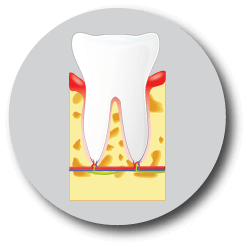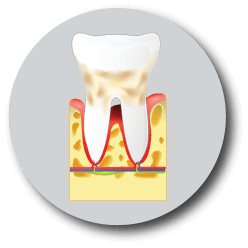Sedation Dentistry
If you have been delaying dental care because of fear or embarrassment, Dental TLC has a solution for you. Sedation dentistry!

Did you know that if you need a periodontal tooth cleaning that having a regular cleaning could actually be a disservice to the health of your teeth and gums? Yes that’s right! Many patients have questions about the difference in teeth cleaning treatments and today we are here to discuss the differences in these types of cleanings.
There are 3 types of cleanings, depending on how healthy your gums are. The term gum disease—or periodontal disease—describes bacterial growth that gradually destroy the tissue surrounding and supporting the teeth. X-rays give a clear view of any bone loss and tartar under the gum line.
“Periodontal” means “around the tooth” and hygiene probing measures the seal around the neck of each tooth. When you hear the hygienist calling out numbers during gum measurements, low numbers are the best. If the numbers are under 4, you will need a regular cleaning. If the numbers are 4 or above, then a deep cleaning may be required.

Gums are healthy. The regular cleaning removes tartar, stain and plaque from the enamel above the gum line.
Healthy gums appear pink, they do not bleed and they hug each tooth tightly. Shallow pocket depths are measured when probed. Normal is between 1 millimeter to 3 millimeters. No tartar or bone loss is detected on the X-rays and gums do not bleed!
Routine dental cleanings are recommended twice a year to keep your gums and teeth in a healthy condition. Gum disease is fast progressing and just because your gums are healthy doesn’t mean you should take them for granted.

If bleeding and inflammation are present, your gums have the early signs of periodontal disease. A gingivitis cleaning removes tartar, plaque and stain and deep tartar incrusted deep below the gum line. This takes more time than a regular cleaning.
Diseased gums easily bleed when probed because of infection and inflammation. They appear red and puffy and their pocket measurements are deeper. Pockets that measure 3 millimeters to 5 millimeters indicate signs of disease.
X-rays detect deep tartar under the gum line at the neck of the tooth, but the bone crests are still intact. Gums can return to a healthy state with frequent regular cleanings and consistent home care.

Here your gums are forever in a diseased state, but still manageable. This cleaning removes deep tartar incrusted on exposed roots, as well as infected and inflamed bone and gum tissue. Anesthetics are used for comfort. Sensitivity occurs because exposed root is porous and no longer insulated by the dome of enamel. Diseased bone bleeds easily, pus is visible and root surfaces are exposed because of the receding gum and bone tissue. X-rays show bone loss advancing and deep tartar encrusted on the exposed roots.
Routine visits to the dentist may be recommended more often than twice per year. Dentist approved plaque-removal devices, such as special toothbrushes, toothpicks or water irrigation tools can improve your at home care. Prescribed anti-plaque, anti-tartar toothpastes and rinses can also help and maintain a healthy mouth.

Scaling: The removal of tartar and bacteria from teeth and beneath gums. This is usually done in a standard professional teeth cleaning.
Root planing: Smoothing the root surfaces to discourage further buildup of tartar and bacterial toxins.
Antibiotics: May include topical antibiotics like mouth rinses and gels, or oral antibiotics.
Flap surgery (pocket reduction surgery): Lifting back gum tissue, exposing the roots for more effective scaling and root planing. The underlying bone may be recontoured so that it will be easier to clean the area around the gums.
Soft tissue grafts: This reinforces soft tissue lost to gum recession. A small amount of tissue from the roof of the mouth is relocated to the gum line in order to reduce further gum loss, cover exposed roots and improve appearance.
Bone grafting: This is done when the bone around the tooth root has been destroyed and helps prevent tooth loss by holding the tooth in place. It also promotes bone regrowth.
Guided tissue regeneration: This promotes regrowth of bone through the use of a biocompatible fabric being placed between the bone and tooth. The material prevents unwanted tissue from growing so that the bone can grow back.
Enamel matrix derivative application: This procedure, another form of guided tissue regeneration, involves the application of gel to a diseased tooth root. The gel contains the same proteins that naturally exist in developing tooth enamel. Its application stimulates healthy bone and tissue growth.
Periodontal disease is something you have to monitor your whole life, kind of like your blood pressure. You can reverse gum disease in it’s early stages, but once the gum detaches, bone is lost and/or the root surface is exposed, you can only treat it to decrease further deterioration. Call Dental TLC at (404) 255-2273 today and schedule your next dental cleaning. It’s our priority to give you the appropriate cleaning to maintain healthy gums and teeth!